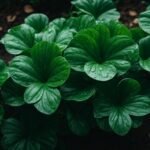Alocasia, often dubbed the “elephant ear plant” due to its large, arrow-shaped leaves, is a captivating tropical plant native to sub-tropical Asia and Eastern Australia. While its beauty is undeniable, ensuring it thrives requires a keen understanding of its soil needs. If you’ve ever wondered about the best soil for Alocasia, you’re in the right place.
Key Insights:
- Alocasia plants are susceptible to root rot if planted in non-ideal soil.
- The choice of potting mix is crucial for indoor Alocasia plants.
- There are both ready-made and DIY soil mix options suitable for Alocasia.
- Proper watering techniques complement the right soil mix.
Introduction to Alocasia Plants
Alocasia plants, with their striking foliage patterns, are a favorite among plant enthusiasts. Native to regions like sub-tropical Asia and Eastern Australia, these plants have found their way into homes across the globe. Commonly referred to as the “elephant ear plant,” this name is also attributed to plants in the Colocasia genus.
The allure of Alocasia lies in its magnificent arrow-shaped leaves. However, its beauty can be short-lived if not planted in the right soil. Alocasia plants can be prone to root rot, especially if the soil mix isn’t ideal. Whether you’re considering crafting your own Alocasia soil mix or opting for a ready-made one, understanding the plant’s needs is paramount.
The Ideal Soil Mixes for Alocasia
Ready-Made Mix: Pray For Us Blend
For those who prefer a hassle-free approach, the Pray For Us blend from Oh Happy Plants is a top recommendation. This mix is not just ideal for Alocasias but also other plants like Prayer Plants, Colocasia, and Crotons.
Why is it Special?
- Moisture Balance: Formulated to retain moisture without over-saturating, reducing the risk of root rot.
- Oxygen Supply: Ensures ample oxygen reaches the roots, a vital requirement for Alocasias.
- Eco-friendly: Contains no peat moss. Instead, it uses coco coir and coco chips.
- Nutrient-Rich: Packed with organic matter like coco coir and alfalfa meal, flax seed meal, and rock dust for nourished growth.
- Disease Resistance: Contains a mycorrhizal inoculant that naturally boosts plant health and vigor.
- Healthy Roots: The inclusion of charcoal promotes a robust root system.
For those environmentally conscious, the absence of peat moss in this blend is a significant plus. Additionally, if you’re not a fan of perlite, this mix has you covered, as it doesn’t use any. Instead, it boasts a rich composition of coco coir, alfalfa meal, flax seed meal, and rock dust, ensuring your Alocasia receives all the nutrients it needs.
DIY Mix: Using Big Perlite
If you’re more of a hands-on gardener, creating your own mix can be both fun and rewarding. A key aspect of Alocasia care is ensuring the soil remains evenly moist while allowing for good drainage. One way to achieve this balance is by amending your favorite potting mix with larger perlite.
Benefits of Using Larger Perlite:
- Improved Drainage: Larger perlite enhances drainage better than its smaller counterpart.
- Increased Aeration: Adds more air to the root zone, benefiting the Alocasia plant.
A recommended product for this purpose is the Mother Earth Size 3 perlite. By simply mixing 2 to 3 parts of your preferred indoor potting mix with 1 part of this perlite, you can achieve the desired soil consistency. If perlite isn’t your thing, horticultural pumice is an excellent alternative.
This article deeply delves into Alocasia care, focusing on the soil aspect. As we continue, we’ll explore another DIY mix option and delve into essential watering tips to ensure your Alocasia survives and thrives. Stay tuned!
DIY Chunky Aroid Mix
For those who love experimenting with different soil textures, the chunky aroid mix is a fascinating option. This mix is particularly popular among Alocasia enthusiasts due to its unique composition.
Components of the Chunky Aroid Mix:
- Equal parts of your preferred indoor potting mix.
- Orchid bark.
- Perlite.
Pros of Using the Chunky Aroid Mix:
- Excellent Drainage: The chunky nature ensures rapid water drainage, minimizing the risk of root rot.
- Reduced Overwatering Risk: The mix’s sharp drainage makes it challenging to overwater your plants.
Cons:
- Frequent Watering: Due to its sharp drainage and less moisture retention, you might water the plant more often.
Tips for Watering Alocasia Plants
Watering is as crucial as the soil mix in Alocasia care. Here are some guidelines to ensure your plant remains hydrated without being waterlogged:
- Monitor Soil Moisture: Always check the top inch of the soil. If it’s dry, it’s time to water.
- Avoid Strict Schedules: Each potting mix has its drying rate. Water is based on the soil’s dryness, not the calendar.
- Understand Your Environment: Light, humidity, temperature, and pot type can influence how quickly the soil dries. Adjust your watering routine accordingly.
FAQs
What is the difference between Alocasia and Colocasia?
While both are commonly referred to as “elephant ear plants,” they belong to different genera. Alocasia plants typically have arrow-shaped leaves, while Colocasia leaves are more rounded.
How often should I water my Alocasia plant?
It depends on the potting mix and environmental conditions. Always check the top inch of the soil. If it’s dry, water the plant. Avoid sticking to a strict schedule.
What are the signs of overwatering or underwatering Alocasia?
Overwatered Alocasia plants may show signs of root rot, while underwatered ones might have yellow leaves at the base. It’s essential to strike a balance for optimal plant health.
How to Propagate Alocasia?
Alocasia can be propagated through two primary methods: division and corms. For division, remove the plant from its pot, inspect the roots, and separate the offsets. Repot the parent plant and its offsets into separate pots. For propagating with corms, remove the tiny round bulbs (corms) from the soil attached to the rhizome. Place the corms in a shallow container with water, ensuring the base is submerged, but the top is exposed. Once roots develop, transplant the corms into perlite and eventually into soil. More details.
How to Care for Alocasia?
Alocasia plants require a well-draining soil mix, consistent moisture without waterlogging, and indirect sunlight. They thrive in high humidity and should be protected from cold drafts. Regularly inspect for pests like spider mites and aphids. Fertilize every 2-4 weeks during the growing season.
Can Alocasia Grow in Water?
Yes, Alocasia can grow in water, especially during the propagation phase. When propagating using corms, they are initially rooted in water. However, for long-term growth, it’s recommended to transplant them into a suitable soil mix.
Do Alocasias Like to Be Root Bound?
No, Alocasias do not prefer to be root-bound. When they outgrow their pots, it’s essential to repot them to ensure healthy growth and prevent root rot.
Do Alocasias Flower?
Yes, Alocasias do produce flowers. However, their flowers are not as showy as their striking foliage. The flower structure is called a spathe and spadix, similar to other plants in the Araceae family.
Conclusion
Alocasia plants, with their captivating appearance, deserve the best care. The right soil mix, combined with proper watering techniques, can ensure they thrive in your home. Whether you opt for a ready-made mix like the Pray For Us blend or prefer a DIY approach, understanding your plant’s needs is the key. Remember, every Alocasia plant is unique, and so are its requirements. Happy gardening!
Sources / For More Information:
How to Keep Indoor Plants Alive in Winter – 7 Crucial Tips (ohiotropics.com)


